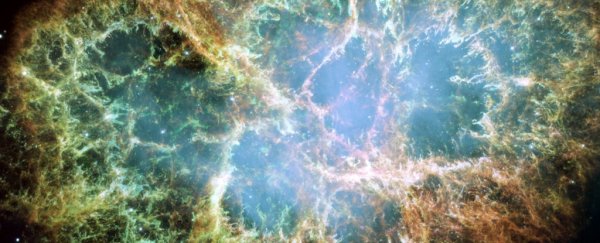Humans and our primate relatives differ in many ways, but the fact we walk on two legs is one of the most obvious. Precisely how our ancestors evolved that trait is a well-debated mystery. Now, there's a new idea. What if one of the contributing factors was giant explosions in the sky?
It's not as crazy as it sounds. According to a hypothesis astronomers have laid out in a new paper, the exploding stars at the end of their lives - supernovae - could have bathed Earth in cosmic radiation, beginning around 8 million years ago, and peaking around 2.6 million years ago.
This radiation would have ionised the lower atmosphere, likely resulting in an increase in cloud-to-ground lightning strikes. This, in turn, could have increased forest fires - eradicating the forests of Africa, where early humans are thought to have originated, and allowing the savannah to take their place.
You see, bipedal locomotion confers a number of advantages to human species, especially in the African savannah where height increases visibility.
"It is thought there was already some tendency for hominins to walk on two legs, even before this event," said astronomer and physicist Adrian Melott of the University of Kansas.
"But they were mainly adapted for climbing around in trees. After this conversion to savannah, they would much more often have to walk from one tree to another across the grassland, and so they become better at walking upright.
"They could see over the tops of grass and watch for predators. It's thought this conversion to savannah contributed to bipedalism as it became more and more dominant in human ancestors."
As you can see, there's still a fair bit of conjecture and connecting the dots from supernovae to savannah. But Melott and his team have brought some receipts.
A few years ago, astronomers revealed they had found a layer of iron-60 isotopes in ancient seabeds - an isotope with no known natural terrestrial production mechanisms, meaning it had to have come from space. And because it has a known half-life, it can be accurately dated.
These isotopes were traced to two events, the first one 6.5 to 8.7 million years ago and the second 1.7 to 3.2 million years ago, within 300 to 163 light-years of Earth.
Based on this information revealed by the iron-60 isotopes, Melott's team has extrapolated what would have been happening on Earth during these bombardments.
"We calculated the ionisation of the atmosphere from cosmic rays which would come from a supernova about as far away as the iron-60 deposits indicate," he said.
"It appears that this was the closest one in a much longer series. We contend it would increase the ionisation of the lower atmosphere by 50-fold. Usually, you don't get lower-atmosphere ionisation because cosmic rays don't penetrate that far, but the more energetic ones from supernovae come right down to the surface."
Ionisation occurs when atoms or molecules become charged by gaining or losing electrons. In this case, the cosmic rays would have knocked a bunch of electrons loose. In turn, electrons help carry lightning from the clouds to the ground, so these loose electrons would have made lightning strikes a lot easier.
So how does this connect to forest fires? There's a whole lot of sooty carbon deposits in the soil that correspond with that bombardment timeframe.
"The observation is that there's a lot more charcoal and soot in the world starting a few million years ago," Melott said. "It's all over the place, and nobody has any explanation for why it would have happened all over the world in different climate zones. This could be an explanation."
It's not likely to be the only explanation - evolution is, after all, a pretty complex phenomenon - but the team's argument certainly makes for an interesting connection between the cosmos and our ancestors.
The research has been published in the Journal of Geology.
